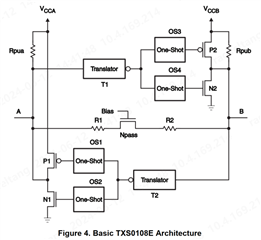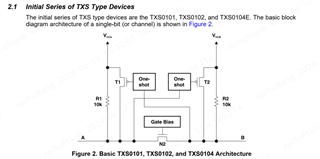Tool/software:
What's the function of R1 and R2?

This thread has been locked.
If you have a related question, please click the "Ask a related question" button in the top right corner. The newly created question will be automatically linked to this question.
The TXS0108E has two more One-Shot than the Initilal Series of TXS, what's the purpose of that?

Without the low-side one-shots, falling edges (from A to B, or from B to A) are pulled low only through these R1/R2 resistors. With the low-side one-shots, falling edges are faster. (R1/R2 are not very large, so the difference is not very large.)
Hi Rachel,
The falling edge one-shot architecture is unique to the TXS0108E allowing for higher data rate capability. It is described further in section 2.2 in A Guide to Voltage Translation With TXS-Type Translators.
Regards,
Jack
Hi Jack,
My question is if there is no R1/R2, and the falling edges are pulled down directly through Npass, the same effect as acceletating the falling edge with two one-shots? So what is the reason for the TXS0108E series?
Regards,
Rachel
As R1/R2 has no intended function, so if remove the R1/R2, and without the two low-side one-shots, the effect of accelerating falling edges in TXS0108E and Initilal Series of TXS is the same. My doubt is that what is the purpose of TXS0108E for the exiting of Initilal Series of TXS?
R1/R2 are not resistors. They describe the resistance of other components (bond wire, traces, MOSFET channel). It is not possible to remove them. (Other TXS devices also have them.)
Hey Rachel,
During a logic low state, the Npass turns on, essentially connecting the input to the output. The falling one shot circuitry helps to bypass the internal 40kohm pullup resistors to give the output an additional edge during a logic low state.
Regards,
Jack